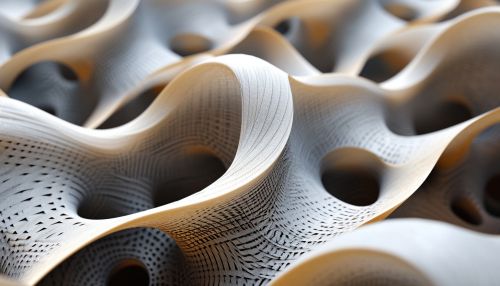Manifold
Introduction
In the field of mathematics, a manifold is a topological space that locally resembles Euclidean spaces near each point. More precisely, each point of an n-dimensional manifold has a neighborhood that is homeomorphic to the Euclidean space of dimension n.
Definition
Formally, a (topological) manifold is a second-countable Hausdorff space that is locally homeomorphic to Euclidean space. The "locally homeomorphic to Euclidean space" condition is defined as follows: for any point x in the manifold, there is a neighborhood of x that is homeomorphic to Euclidean space.


Types of Manifolds
Manifolds can be categorized into several types, based on their properties and the mathematical structures they carry.
Differentiable Manifolds
A differentiable manifold is a manifold that has a differentiable structure. This means that the manifold is equipped with a globally defined differential structure that allows for the differentiation of functions defined on the manifold.
Riemannian Manifolds
A Riemannian manifold is a real differentiable manifold in which each tangent space is equipped with an inner product in a manner which varies smoothly from point to point. This allows one to define various notions of smoothness, such as gradients of functions, divergence and curl of vector fields, and so on.
Complex Manifolds
A complex manifold is a manifold with an atlas of charts to the open unit disk in Cn, such that the transition maps are holomorphic.
Properties of Manifolds
Manifolds exhibit various properties that make them a central object of study in many areas of mathematics.
Dimension
The dimension of a manifold is defined as the dimension of its local Euclidean spaces. It is a topological invariant of the manifold.
Compactness
A manifold is said to be compact if it is a compact topological space. This means that any open cover of the manifold has a finite subcover.
Connectedness
A manifold is said to be connected if it is a connected topological space. This means that it cannot be represented as the union of two or more disjoint nonempty open subsets.
Orientability
A manifold is said to be orientable if it has a consistent choice of orientation, which is a function that assigns to each point of the manifold a (linear) orientation of the tangent space at that point.
Applications of Manifolds
Manifolds have wide applications in various fields of science and engineering.
In physics, manifolds represent the space-time in general relativity, and the phase space in classical mechanics.
In engineering, manifolds are used in control theory, particularly in the design of controllers for nonlinear systems.
In computer science, manifolds are used in machine learning algorithms, particularly in the design of manifold learning algorithms for dimensionality reduction.
